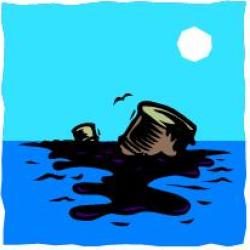Source Institutions
Add to list Go to activity
Activity link broken? See if it's at the internet archive

This hands-on experiment will provide learners with an understanding of the issues that surround environmental cleanup. Learners will create their own oil spill, try different methods for cleaning it up, and then discuss the merits of each method in terms of effectiveness (cleanliness) and cost. They will be asked to put themselves in the place of both an environmental engineer and an oil company owner who are responsible for the clean-up.
- 5 to 10 minutes
- 1 to 2 hours
- $1 - $5 per group of students
- Ages 8 - 14
- Activity, Experiment/Lab Activity, Lesson/Lesson Plan, Simulation
- English
Quick Guide
Materials List (per group of students)
- 1 aluminum pie pan
- A large stone that fills about 20% of the pie pan (learners can bring this in from home during the 2 weeks leading up to class)
- 2 bird feathers from a hobby shop
- 1 plastic spoon for skimming oil from the pie pan
- 1 small graduated cylinder (about 20 ml) for placing spoonfuls of skimmed oil/water
- 1 small funnel for adding skimmed oil/water to test tubes
- 4 oil absorbing cloth pads for absorbing oil (obtained by cutting big sheet into squares or using cotton balls/squares)
- 1 small squeeze bottle of Dawn® (or any "grease fighting") dishwashing detergent labeled "Dispersant"
- 2 copies of the Oil Spill Worksheet
- Pitchers/jugs of water
- Plastic squeeze bottle (about 100 ml) containing dark vegetable oil (can be died with food coloring)
- A surplus of paper towels
- 1 large garbage bag for clean up
Subjects
-
Earth and Space Science
-
Earth Structure
- Oceans and Water
-
Earth Structure
-
Engineering and Technology
-
Engineering
- Environmental Engineering
- Technology
-
Engineering
-
Physical Sciences
-
Chemistry
- Solutions
-
Structure and Properties of Matter
- Volume and Density
-
Chemistry
-
Life Sciences
-
Diversity of Life
- Animals
-
Ecology
- Ecosystems
- Human Impact
-
Diversity of Life
-
Mathematics
-
Data Analysis and Probability
- Data Analysis
- Data Collection
- Data Representation
- Reasoning and Proof
- Representation
-
Data Analysis and Probability
-
The Nature of Technology
-
Technology and Society
- Impacts of Technology
- Technology and the Environment
-
Technology and Society
-
The Nature of Science
-
Science and Society
- Risks and Benefits
- Ethics
-
The Scientific Process
- Asking Questions
- Conducting Investigations
- Gathering Data
- Formulating Explanations
- Communicating Results
-
Science and Society
Informal Categories
- Animals
- Nature and Environment
Audience
To use this activity, learners need to:
- see
- read
- touch
Learning styles supported:
- Involves teamwork and communication skills
- Uses STEM to solve real-world problems
- Involves hands-on or lab activities
Other
Includes alignment to state and/or national standards:
Includes assesments for student learning:
This resource is part of:
Access Rights:
- Free access
By:
- Integrated Teaching and Learning Program, College of Engineering, University of Colorado at Boulder
Source Collection
- TeachEngineering
Rights:
- All rights reserved, Regents of the University of Colorado, 2007
